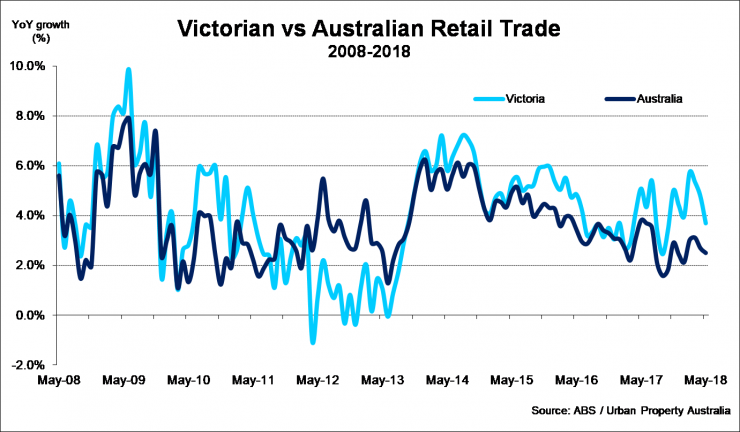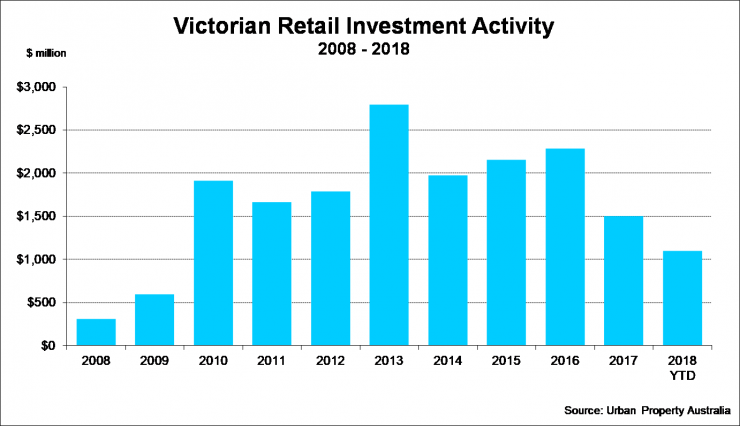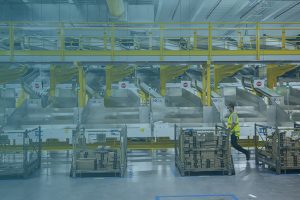Melbourne Retail Market Outlook – July 2018
July 25th 2018 | , Urban Property Australia
Victorian retail investment activity is on track to achieve record highs in 2018, with already $1.1 billion sold in 2018 to date. Despite soft retail trade conditions, there continues to be demand from major both domestic and offshore institutions to acquire trophy retail assets in Victoria.
Retail Trade
Retail spending growth in Victoria outperformed all other major Australian states in the 12 months to May 2018, increasing by 3.7%. However, annual growth remains below Victoria’s five-year annual average growth rate of 4.8%.
Food (4.1%) and Other retailing (15.5%) were the only major retail categories in Victoria to record growth above their five-year average in the 12 months to May 2018. While still outperforming many other retail categories, retail trade growth continues to ease in the food retailing and cafes, restaurants and take away sectors. However, looking ahead, Victoria’s strong population growth should continue to support trade in food, cafes, restaurants and take away retailers relative to other retail sectors.
Retailers continue to prioritise investment in their supply chains and online platforms as opposed to expanding their physical presence.
Australian consumers have spent approximately $26.08 billion in the 12 months to May 2018, accounting for around 8.3% of spending at traditional “bricks & mortar” retailers over the year. According to the National Australia Bank, online retail sales increased by 1.2% in May, with online sales for the year to May 2017 up by 17.2%.
Looking forward, while consumer sentiment is currently interpreted as optimistic, high levels of household debt and the increasing borrowing costs are still major risk factor to retail spending.

Retail Strip Market
Total vacancy across Melbourne’s prime retail strips remains elevated, albeit with vacancy declining marginally to 7.9% as a number of residential developments across the strips were completed. Of all of Melbourne’s prime retail strips, only the vacancy rate of Toorak Road, South Yarra sits below its long-term average. Over the year to July 2018, Burke Road, Camberwell; High Street, Armadale; Toorak Road, South Yarra and Acland Street, St Kilda recorded decreases in vacancy. As has been the case since 2012, the vacancy rate of Bridge Road, Richmond remains highest amongst the prime retail strips with the current vacancy sitting at 19%.
Tenant demand for Melbourne’s retail strips has been driven by food-based retailers and service retailing occupants boosted by the population growth that has resulted from the number of apartments recently completed close to the popular shopping precincts.
Despite the elevated vacancy levels and soft retail trading conditions, investment demand for strip retail assets remains intense with transactions demonstrating yields between 2.5% and 4.0% for properties on prime strips.
Rising population is expected to boost retail trade and lower vacancy rates in the medium term. Looking ahead, rents are expected to stabilise over the short term with vacancy plateauing and landlords gradually adapting to achievable rents.
CBD Retail Market
As at July 2018, Melbourne’s CBD retail overall vacancy remained stable to 3.0% with a slight increase of vacancy within shopping centres compared to premises offering street frontage which saw vacancies fall. Over the year, most of the incoming tenants into the Melbourne CBD comprised occupiers from food retailing with international brands also increasing their presence in the Melbourne CBD retail market.
Melbourne CBD-based employment and residential population growth continues to underpin demand for CBD retail space from both domestic and international retailers. According to the Australian Bureau of Statistics, between June 2016 and June 2017 the CBD residential population increased by 11.2% to reach 46,104, while CBD white collar employment increased by 6.0% to reach 301,825 in the three years to December 2017.
Furthermore, total inbound international tourism numbers for Victoria increased by 16% to reach 2.9 million over the 12 months to December 2017, with Chinese tourists leading the influx which has supported the continued growth of luxury international retailers in the Melbourne CBD retail market.
International retailers who have recently opened stores in the Melbourne CBD include: Versace, Fendi, Bottega Veneta, Debenhams and Burberry have new premises scheduled to open in the second half of 2017.
Construction of the Melbourne Metro Tunnel project will continue to result in some disruption to retail trade, however longer term it is expected the addition of two new CBD rail stations will positively impact retail trade in Melbourne’s CBD.

Sales Activity
The 12 months to July 2018 marked another very active year for the Victorian retail investment market. Total transactions reached $2.5 billion in 2017/18, the fourth highest volume of retail sales in a financial year and 42% above the long-term average. Sales volume in 2017/18 was boosted by a number of significant transactions highlighted by QIC’s recent purchase of two 50% stakes in the Werribee Plaza and Pacific Epping shopping centres which totalled $500 million in June 2018.
Domestic institutions dominated Victorian retail sales acquisitions in 2017/18 as many capitalised on the opportunity to invest in regional and major-regional shopping centres with QIC, GPT, Charter Hall and Newmark Property all acquiring major retail assets. Yields remained stable in the 12 months to July 2018 reflecting the soft retail trade conditions despite the elevated transaction volume.
Within the CBD retail market specifically, sales volumes fell substantially in the year to July 2018 compared with previous 12 months, which was underpinned by the $247 million sale of St Collins Lane for $247 million was the largest Melbourne CBD retail transaction in 10 years. Prime yields for freehold retail assets (excluding shopping centres and arcades) compressed marginally over the 12 months to July 2018 to now range between 3.0% and 4.0% whilst prime yields for strata retail assets range between 3.5% and 4.0%.
Looking ahead, the volume of Victorian retail transactions across retail asset classes could reach a new record high in 2018, with already $1.1 billion sold in 2018 to date. There continues to be demand from major both domestic and offshore institutions to acquire trophy retail assets in the traditionally tightly held retail sector.



